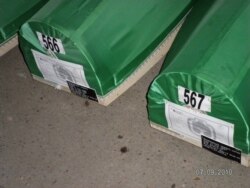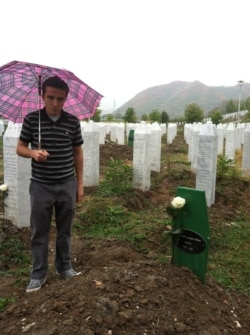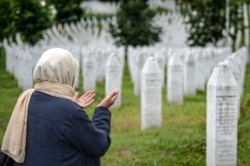Behidin Piric never had the chance to know his maternal grandfather.
In 2009, the St. Louis, Missouri, resident received a phone call from his native Bosnia informing him that his grandfather’s body had been found in a mass grave with his hands tied behind the back with barbed wire. He had two bullet wounds in the back of his head.
“I had the task of telling my mother who came home from work that they found her father, so that was a pretty tough thing to do,” said the 27-year-old American student.
Piric’s grandfather was one of more than 8,000 Bosnian Muslim civilians, mostly men, who were killed in the town of Srebrenica during the Bosnian war.
“The genocide began in Srebrenica in July of 1995 and was a catastrophic uprooting of multiple generations of Bosnian Muslim families,” said Ida Sefer, president of the Chicago-based Bosnian-American Genocide and Education center, in an e-mail interview with VOA.
She said Bosnian Serbs backed by neighboring Serbia used torture, sexual assault, forced impregnation, concentration camps, rape camps, ethnic cleansing and murder against the Bosnian Muslim population in the three years after Bosnia declared its independence from the former state of Yugoslavia in 1992.
The International Criminal Court in The Hague convicted former Bosnian Serb military chief Ratko Mladic of genocide, war crimes and crimes against humanity, and sentenced him to life imprisonment in 2017. Former Bosnian Serb President Radovan Karadzic was convicted in 2016 for his war crimes and role in perpetrating the genocide.
Officials from the Serbian Embassy in Washington did not respond to repeated requests for comment.
July 11 marks the 25th anniversary of the Srebrenica massacre. Decades later, survivors and other Bosnians still have a difficult time speaking about the calamities they went through.
“We will never heal. Our loss is so huge, so enormous that we will never heal, especially my generation,” said Senada Pargan, a Srebrenica survivor and one of the more than 21,000 Bosnian refugees who came to the United States in the years after the massacre. “Twenty-five years later, we are still searching for [the remains of] our loved ones.”
Pargan resides today in Lansing, Michigan, where she has been living since 2001. She was 17 years old when Srebrenica fell to Serbian forces and her home was bombed. Sobbing during a phone interview, she said she lost 99 family members including uncles and cousins as well as neighbors, friends, and classmates.
The tragedy was compounded, she said, by lengthy periods when the villagers had no access to food or medicine.
She fled to the nearby village of Potacari, which is now home to the Srebrenica Genocide Memorial and a cemetery for the victims. In 1995, Potacari served as a place of refuge for Muslims from other parts of Bosnia.
Pargan was separated from her parents and brother initially, but managed to reunite with them later. She describes the night of July 12, 1995 as one of the most painful.
“They were taking people and killing them and torturing them,” she said. “Everything was so quiet, but you can hear screaming of whoever they were torturing somewhere close to us.”
Pargan wrote two books, “A Sorrow for Silence” in 2011 and “Darkness of Silver Lights” in 2015, made up of poems and stories dedicated to people she loved or situations she faced during the war.
“There was only one story that I still cannot write about and I don’t even know when I will be able to write about it,” she said. That story is about one of her best friends who was killed when he tried to steal food from a neighboring Serbian village to feed her. At the time, Pargan had not eaten in nine days.
Piric’s family came to America in 2000 and now lives in St. Louis, home to the largest Bosnian community in the United States. Piric is studying history at the University of Missouri and is an intern for the Bosnia Memory Project at Fontbonne University in St. Louis.
The purpose of the initiative is to record the culture and experiences of Bosnian genocide survivors through interviews, books, letters, and photographs.
The Bosnian war was already underway when Piric was born in Srebrenica in 1992. His earliest memory is of leaving Tuzla, the third-largest city in Bosnia, with his parents and brothers after the war ended with the signing of the Dayton Accords by the presidents of Bosnia, Serbia, and Croatia in November 1995.
“I remember being in the back of the U.N. truck and seeing soldiers and a bunch of other people,” he recalled. “After that, I have a lot of memories of the rebuilding of the country – the tensions that were still there in the city where I lived after the war. There was still a lot of religious tension, ethnic tensions.”
Piric’s father was wounded during the war when a mine exploded, damaging his legs while he was farming potatoes. Besides his grandfather, Piric also lost his maternal grandmother, an uncle, and “countless cousins.”
Like Pargan, he said that he and his parents still cannot heal from the tragic events at Srebrenica even though 25 years have gone by.
“When I go back to Srebrenica to the memorial, it’s a strange feeling,” he said. ”There’s a feeling of dread. The hairs on the back of my neck stand up. I get goose bumps, so it’s difficult.”
Retelling the story of Srebrenica to future generations and never forgetting all those who were lost has become a mission for the Bosnian community in the United States, especially as some Bosnian Serb officials continue to deny that a systematic genocide occurred during the war.
“Remembering the 8,372 victims and their families during this time is an important part of preventing genocide in the future, meaning uplifting the voices of the survivors,” Sefer said.
“Listening to survivor testimonials, reading the stories of their loved ones, humanizing the people who were murdered, is all a part of remembering.”









